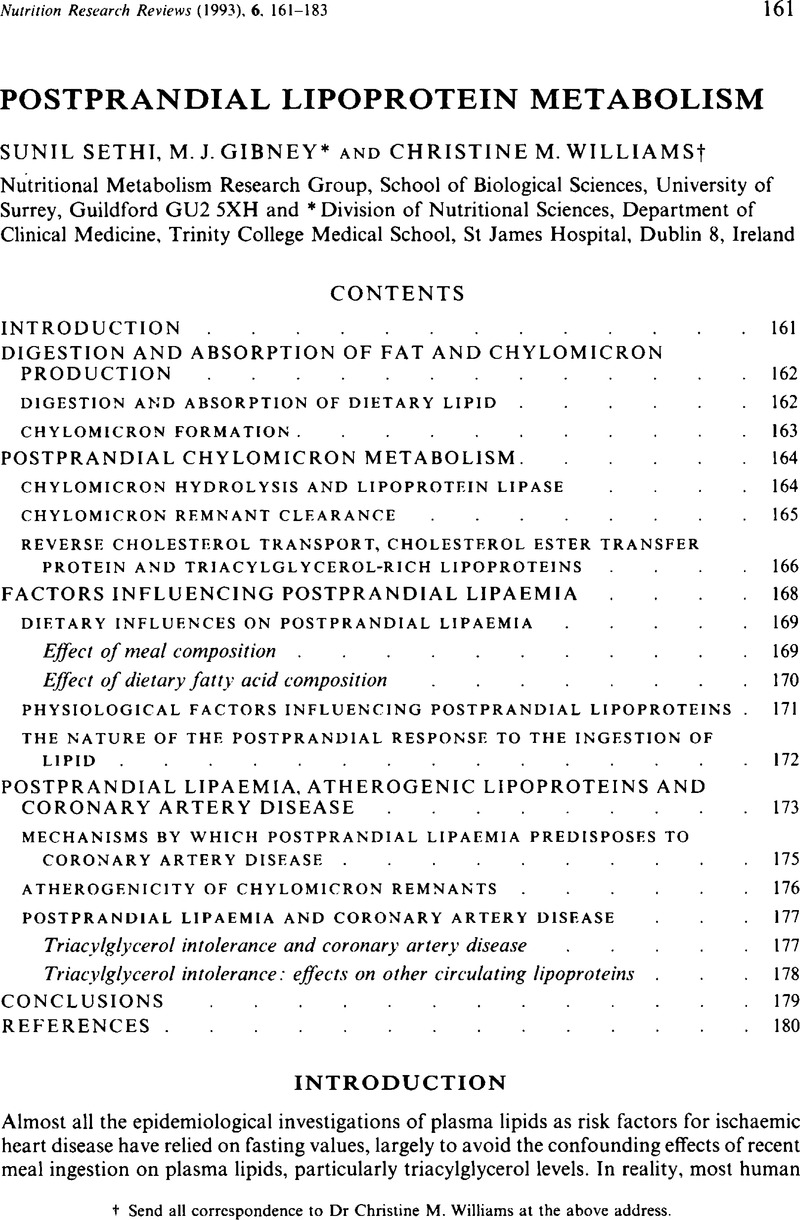Crossref Citations
This article has been cited by the following publications. This list is generated based on data provided by Crossref.
Sandström, Brittmarie
Hansen, Lene Trond
and
Sørensen, Annemarie
1994.
Pea Fiber Lowers Fasting and Postprandial Blood Triglyceride Concentrations in Humans , .
The Journal of Nutrition,
Vol. 124,
Issue. 12,
p.
2386.
1994.
Abstracts of Communications.
Proceedings of the Nutrition Society,
Vol. 53,
Issue. 3,
p.
158A.
1995.
Abstracts of Communications.
Proceedings of the Nutrition Society,
Vol. 54,
Issue. 1,
p.
1A.
Roche, Helen M.
and
Gibney, Michael J.
1995.
Postprandial triacylglycerolaemia—Nutritional implications.
Progress in Lipid Research,
Vol. 34,
Issue. 3,
p.
249.
Kubow, Stan
1996.
The influence of positional distribution of fatty acids in native, interesterified and structure-specific lipids on lipoprotein metabolism and atherogenesis.
The Journal of Nutritional Biochemistry,
Vol. 7,
Issue. 10,
p.
530.
Williams, Christine M.
1996.
Disposition of lipids in the postprandial state.
Proceedings of the Nutrition Society,
Vol. 55,
Issue. 1B,
p.
79.
Levrat, Marie‐Anne
Moundras, Corinne
Younes, Hassan
Morand, Christine
Demigné, Christian
and
Rémésy, Christian
1996.
Effectiveness of resistant starch, compared to guar gum, in depressing plasma cholesterol and enhancing fecal steroid excretion.
Lipids,
Vol. 31,
Issue. 10,
p.
1069.
Marckmann, Peter
Bladbjerg, Else-Marie
and
Jespersen, Jørgen
1997.
Dietary Fish Oil (4 g Daily) and Cardiovascular Risk Markers in Healthy Men.
Arteriosclerosis, Thrombosis, and Vascular Biology,
Vol. 17,
Issue. 12,
p.
3384.
Moundras, Corinne
Behr, Stephen R.
Rémésy, Christian
and
Demigné, Christian
1997.
Fecal Losses of Sterols and Bile Acids Induced by Feeding Rats Guar Gum Are Due to Greater Pool Size and Liver Bile Acid Secretion.
The Journal of Nutrition,
Vol. 127,
Issue. 6,
p.
1068.
Joannic, JL
Auboiron, S
Raison, J
Basdevant, A
Bornet, F
and
Guy-Grand, B
1997.
How the degree of unsaturation of dietary fatty acids influences the glucose and insulin responses to different carbohydrates in mixed meals.
The American Journal of Clinical Nutrition,
Vol. 65,
Issue. 5,
p.
1427.
Favier, Marie-Laure
Bost, Pierre-Etienne
Guittard, Christine
Demigné, Christian
and
Rémésy, Christian
1997.
Reciprocal influence of fermentations and bile acid excretion on cholesterol-lowering effect of fermentable carbohydrate.
The Journal of Nutritional Biochemistry,
Vol. 8,
Issue. 3,
p.
127.
Williams, Christine M.
1997.
Postprandial lipid metabolism: effects of dietary fatty acids.
Proceedings of the Nutrition Society,
Vol. 56,
Issue. 2,
p.
679.
Shishehbor, Farideh
Roche, Helen M.
and
Gibney, Michael J.
1998.
The effect of acute carbohydrate load on the monophasic or biphasic nature of the postprandial lipaemic response to acute fat ingestion in human subjects.
British Journal of Nutrition,
Vol. 80,
Issue. 5,
p.
411.
Roche, Helen M.
1999.
Dietary carbohydrates and triacylglycerol metabolism.
Proceedings of the Nutrition Society,
Vol. 58,
Issue. 1,
p.
201.
Williams, Christine M.
1999.
Lipids in Health and Nutrition.
p.
65.
Hansen, Harald S.
Moesgaard, Birthe
Hansen, Henrik H.
Schousboe, Arne
and
Petersen, Gitte
1999.
Formation ofN‐acyl‐phosphatidylethanolamine andN‐acylethanolamine (including anandamide) during glutamate‐induced neurotoxicity.
Lipids,
Vol. 34,
Issue. S1Part3,
Nielsen, Nina S.
Marckmann, Peter
and
Høy, Carl-Erik
2000.
Effect of meal fat quality on oxidation resistance of postprandial VLDL and LDL particles and plasma triacylglycerol level.
British Journal of Nutrition,
Vol. 84,
Issue. 6,
p.
855.
Roche, Helen M
and
Gibney, Michael J
2000.
Effect of long-chain n−3 polyunsaturated fatty acids on fasting and postprandial triacylglycerol metabolism.
The American Journal of Clinical Nutrition,
Vol. 71,
Issue. 1,
p.
232S.
Demigné, Christian
Rémésy, Christian
and
Morand, Christine
2001.
Handbook of Dietary Fiber.
p.
155.
Henriksen, Finn L.
Petersen, Per H.
Beck-Nielsen, Henning
and
Hørder, Mogens
2001.
Calibration, Specificity and Trueness of a Postheparin Plasma Lipoprotein Lipase Assay.
Clinical Chemistry and Laboratory Medicine,
Vol. 39,
Issue. 3,





